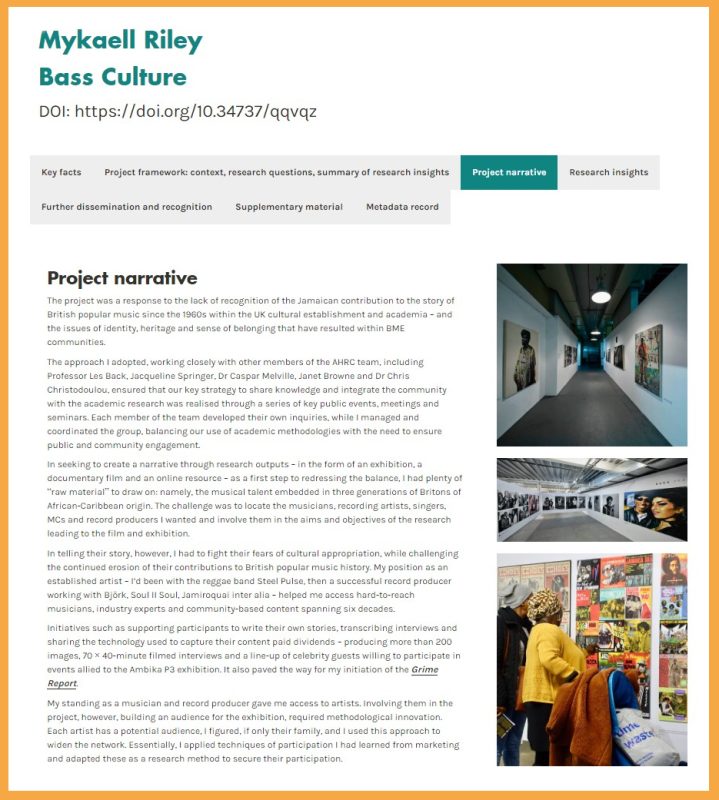Jenny Evans (Principal Investigator) talks to Neal White (Co-Investigator, an artist and Co-Director of CREAM) about their Arts and Humanities Research Council award; Practice Research Voices (PRVoices).

Started in January 2022, the PRVoices project has built on the foundation work carried out at the University of Westminster between 2018 and 2021 – a collaboration with CREAM and its practice researchers – to develop an institutional repository platform that captures, shares and makes discoverable not only traditional text based publications and datasets but all research outputs including the non-text based outputs and collections that are created as part of practice research. PR Voices aimed to review the University of Westminster approach to art and design portfolios submitted to the Research Excellence Framework 2021 and identify how they could be scaled to meet the needs of researchers, not only in art and design but also other practice research disciplines, such as architecture, music, performing arts, media and beyond.
NW: Drawing on your expertise in Libraries and Research administration, could you talk about how you see the project scaling up from capturing, preserving and making discoverable (where possible) the audit of our own REF portfolios to informing standards to enable the capture of all practice research?
JE: University repositories were originally developed to enable (mainly STEM) researchers to share their research publications and make them open access. More recently there has been a move to share research data (including software) via data repositories. This has resulted in platforms that are focussed on these types of ‘outputs’ and discoverability mechanisms (e.g. Google Scholar) that recognise these – often a single file, usually a PDF. Also, STEM researchers, care less about how their research looks in repositories, whereas arts researchers do.
NW: In other words, many of our colleagues are concerned that our research does not always look great in many repository solutions, and these are incredibly varied.
JE: Exactly. When I joined the University in late 2016 (from Middlesex) I was very aware of this landscape and when I discovered we had the opportunity to work with an external company; Haplo (who developed our online research environment for staff and graduate researchers) to build a repository that could not only handle publications and data but also practice research – I jumped at it. This was something that could only happen with buy-in from our research community. I was extremely grateful to be able to work in such close partnership with colleagues in CREAM.
NW: I had worked very closely with Library colleagues in my previous institution to try and improve how we captured practice research in our institutional repository. So when I joined CREAM at Westminster, a pioneer in practice research, there was already recognition that we needed to address this area, and Prof Tom Corby (now at UAL) had seen the opportunity to use the software to improve how we managed/prepared our REF submission. While this didn’t all quite happen in the order we planned, we have made a huge amount of progress – which has resulted in the recent publication of some of our REF2021 portfolios.
Why does this matter? So much work goes into preparing our portfolio submissions. In the end, REF de-railed our plans a little as the REF Outputs module development took priority and there just wasn’t time in the end to use it quite as we planned. However, what Jenny and her team (Repository and Open Access Manager, Nina Watts and Research Data Management Officer, Holly Ranger) with input from colleagues in CREAM, have launched is a repository that recognises and reflects the nuances of practice-based arts, design and media research, and what can be made open access from our REF2021 portfolio submissions.

JE: What struck me was that our arts (and architecture) research, both very high performing areas within the University, were simply missing from the institutional picture of our research activities. Research funders don’t mandate open access for practice research, and anyway open research for these disciplines looks a bit different – it’s a combination of open access and data sharing – where you might not make every single file openly available, but you can capture them together, make open those elements that can be made open, and then the rest can be hidden from public view.
This is also really important in terms of preservation of this research – you cannot preserve content you haven’t captured.
NW: When we say preservation, we are talking about actions supported by policy and strategy to ensure access to files, and therefore knowledge of process, methods and insights in the long term. So how did we get to the PRVoices project?
JE: Over the past 3.5 years, I have spoken at many conferences about the work we have done and the lessons we have learned. What was clear was that many different communities including researchers and practitioners but also repository managers, research data managers, archivists, records managers, curators, librarians, software developers and research managers, were struggling with this. So bringing together these voices was so important, as was having that recognition from a research funder.
We were also able to contribute our perspective about everything we had learned to our data gathering colleagues at Goldsmiths, as part of a report commissioned by the Practice-Research Advisory Group, and authored by James Bulley Ozdin Sahin (2021) ‘How can practice research be shared?’.
Finally, in order to effect real change, this work had to engage a diverse international community. Discoverability of research links to search engines like Google, also connects up to metadata, which is what enables different systems to talk to each other. While persistent identifiers (like DOIs) make it easier to find research and researchers, all of which are internationally recognised standards. These standards don’t work very well for practice research and we had been working with colleagues at Jisc to raise awareness of this. Once you get these standards right then all the relevant software/systems can recognise this research. And the organisations that own these standards need to know that the community agrees on what this research looks like. That’s why taking it beyond Westminster and bringing on board Jisc, the British Library and Kings College London was so important.
NW: In terms of defining the PRVoices Project, we are taking institutional based knowledge capture and moving beyond this to see how we might create an open access standard, so that other institutions, including those beyond academia, can produce knowledge based on these standards without the draining investment of resources, time and energy.
JE: PRVoices is one of a number of projects funded by AHRC’s Scoping Future Data Services for the Arts and Humanities call which underpins their infrastructure for Digital Arts and Humanities (iDAH) programme, part of a strategic approach to arts and humanities infrastructure that aims to enable knowledge with impact. (We are also collaborating with the SPARKLE project, led by the University of Leeds). Our project focuses on using and updating existing open-source software and open standards, enabling the work we do to scale to other software and so benefiting all those engaged in and supporting practice research. It will also inform a platform bid to AHRC to develop an Open Library of Practice Research and its associated supporting and enabling environment.
NW: Thanks Jenny. We look forward to seeing how the project progresses.